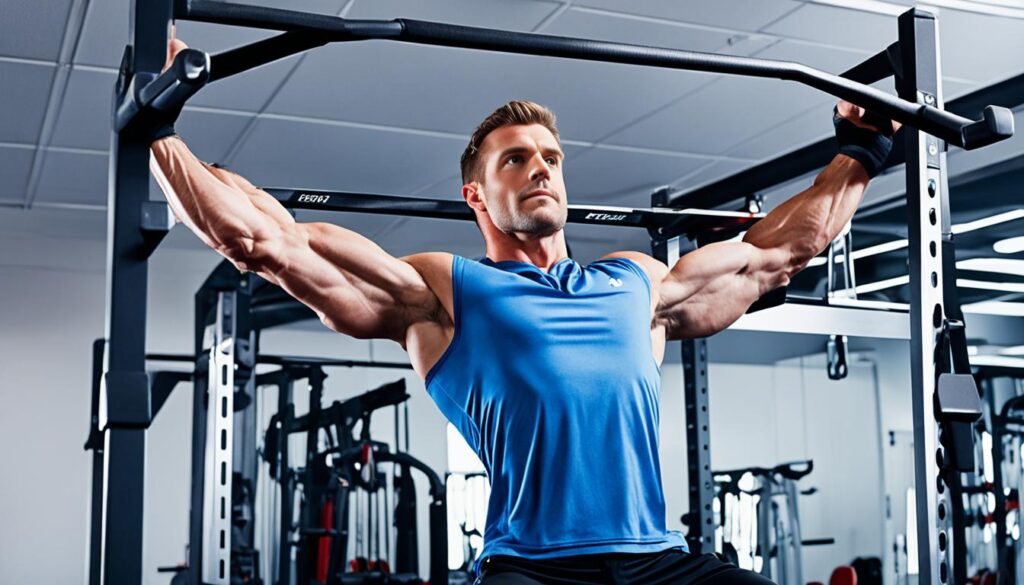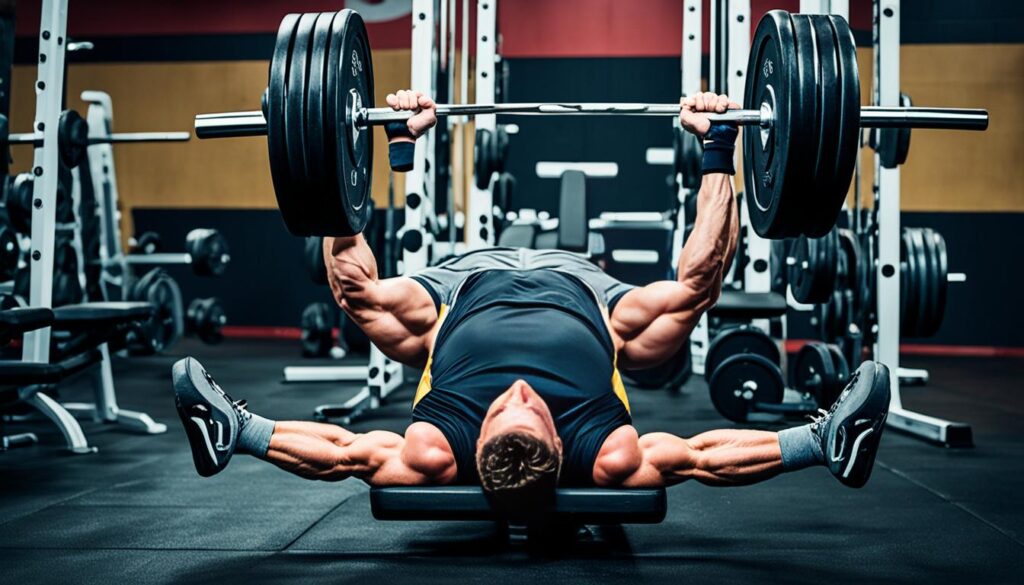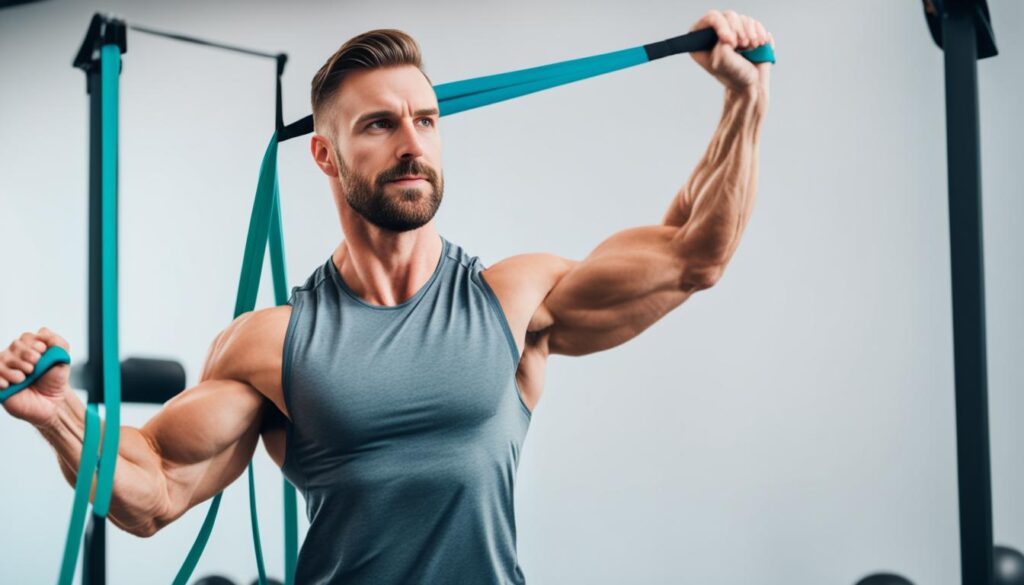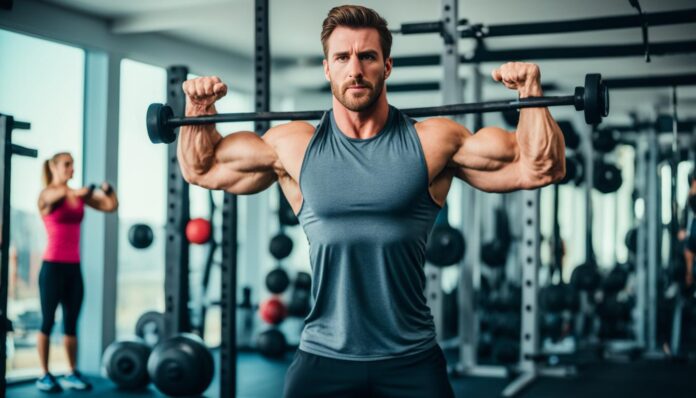Are you tired of spending hours in the gym, only to feel like you’re not making the progress you desire? Look no further than the full-body workout – the secret to maximizing your time and achieving your fitness goals.
Full-body workouts are one of the most efficient and effective types of training, whether performed with barbells, dumbbells, or bodyweight exercises. They allow you to target multiple major muscle groups in a single session, leading to increased strength, improved overall performance, and time-efficient training1. The key to an effective full-body workout is incorporating compound exercises that utilize the major movement patterns: squat, hinge, push, pull, and carry2.
Key Takeaways
- Full-body workouts are a time-efficient way to target multiple muscle groups in one session.
- Compound exercises that engage multiple joints and muscle groups are crucial for effective full-body workouts.
- A well-designed full-body workout program should include a warm-up, main training blocks, and a cool-down.
- Proper form and movement patterns are essential to avoid imbalances and prevent injuries.
- Full-body workouts can be tailored to suit individuals of all fitness levels, from beginners to advanced lifters.
What is a Full-Body Workout?
A full-body workout is a training program that targets all the major muscle groups in a single session, in contrast to split routines that focus on specific body parts on different days3. Typical full-body workout exercises can engage major muscle groups like dumbbell rows, chest presses, deadlifts, squats, overhead presses, and core exercises3. Split training schedules for different muscle groups can range from three to five days, with examples of traditional split routines like legs, chest, shoulders, back, and arms3.
Benefits of Full-Body Workouts
The main benefits of full-body workouts include targeting multiple major muscle groups, improving overall athleticism and functionality, promoting muscle growth and strength, and efficient use of training time3. Recommendations state that taking at least 48 hours between full-body workouts is beneficial, and having at least one to two days off per week from full-body workouts is suggested to allow for proper recovery and prevent injuries3. Compound movements in full-body workouts mimic real-life functional movements like squats, deadlifts, chest presses, and overhead presses3.
Full-body workouts can also improve cardiovascular health by increasing heart rate while working multiple muscles3. Rowing is cited as a full-body workout engaging muscles in the back, shoulders, arms, core, hips, and legs3, and swimming engages muscles in the back, shoulders, arms, core, hips, and legs, providing a low-impact full-body workout3. Resistance workouts using body weight, bands, dumbbells, or household items target various muscle groups and aid in building strength and bone density3. Dance workouts offer a full-body engagement and can stimulate mental engagement with learning new routines or styles3, while HIIT (High-Intensity Interval Training) workouts typically involve short bursts of intense exercises followed by rest periods and are beneficial for cardiovascular fitness3.
“Full-body workouts can be an efficient and effective way to train, engaging multiple muscle groups in a single session and promoting overall fitness and strength development.”
The Importance of Movement Patterns
When designing an effective full-body workout, it’s crucial to focus on the major movement patterns rather than just individual muscle groups4. A combination of seven key movement patterns – squat, hinge, push, pull, carry, lunge, and rotate – can help target all the major muscle functions, aiding in muscle building, weight maintenance, and injury prevention5.
Squat Pattern
The squat pattern is a fundamental movement that engages major muscle groups like the quads, glutes, and posterior chain4. Exercises like squats and reverse barbell lunges effectively work the hamstrings and glutes, while also promoting lower-body strength and functionality4.
Hinge Pattern
The hinge pattern, exemplified by exercises like the barbell deadlift, primarily targets the powerful posterior chain muscles, including the glutes, hamstrings, and lower back4. Incorporating these compound, multi-joint movements is crucial for developing total-body strength and balanced muscle development4.
“Compound exercises in full body workouts engage multiple muscle groups simultaneously, leading to increased strength and overall performance.”4
By focusing on these fundamental movement patterns, full-body workouts can provide a time-efficient and comprehensive approach to strength and muscle development4. The balanced emphasis on these patterns helps ensure that all major muscle groups are adequately targeted, leading to improved overall fitness and functionality465.
Push Pattern
The push movement pattern, which targets the chest, shoulders, and triceps, is another essential component of a full-body workout. Exercises that involve pushing a weight away from the body, such as the barbell bench press, help build upper body pushing strength and muscle7.
Untrained individuals may experience substantial increases in muscle thickness in their chest after two to three months of bench press training7. The triceps, however, grow at a reduced rate compared to the chest muscles from the bench press, with most of the growth occurring in the lateral head7.
The barbell bench press is recommended at 5 sets of 4 to 6 repetitions for an ultimate push-day routine7. The overhead press is suggested at 3 to 5 sets of 6 to 10 repetitions in an ultimate push-day workout7. Dumbbell flye exercise can be done at 2 to 4 sets of 10 to 15 repetitions during a push-day routine7, and dumbbell lateral raise is advised at 2 to 4 sets of 10 to 15 repetitions for a push-day workout7. Overhead triceps extension can be performed at 2 to 4 sets of 10 to 15 repetitions during a push-day routine as well7.
Recent research has shown that the push-pull style of training, as opposed to focusing on a single muscle group each day, can lead to maximal strength gains8. Beginners with less than 6 months of training are recommended to follow a push-pull regimen with a maximum of 3 training days per week8, while intermediate weightlifters (6 months to 2 years of experience) should consider training 3–4 days per week8. Advanced lifters (more than 2 years of experience) can train up to 6 times per week with 1 rest day separating each split8.
The push-pull training regimen supports muscle recovery by providing recommended 48–72 hours of rest to fully recover before training again8. The sample push-pull routine includes performing 3–4 sets of 8–12 repetitions for each exercise and resting for 2–3 minutes between sets8. Using a weight that allows barely performing the desired number of repetitions is suggested to ensure challenging workouts8, and incorporating variety into the workout routine is advised to avoid boredom and stimulate different muscles effectively8.
Push, Pull, Legs (PPL) is designed to build muscle in almost every muscle group by following a split where one trains either upper-body pushing muscles (push), upper-body pulling muscles (pull), or the entire lower body (legs) on specific days of the week9. Ideally, hitting each session twice weekly is recommended9. An example split includes training chest, shoulders, and triceps on push days, back, traps, and biceps on pull days, and legs, glutes, and abs on leg days9. The PPL method can be split over three or six days, allowing for more frequent muscle group training9, and training six days a week with PPL can be effective for bodybuilding purposes9. The simplicity of the PPL split enables focusing on specific movement patterns and muscle groups9, though it may not be suitable for individuals who lack time for 3 to 6 sessions per week9. The effectiveness of PPL comes from its structured categorization of movements and muscles9, and the best push exercises for PPL include Bench Press, Dumbbell Bench Press, Overhead Press, and Push Press97.
Pull Pattern
Complementing the push pattern, the pull pattern focusing on the back and biceps muscles is also crucial for a balanced full-body routine. Exercises like pull-ups and rows that involve pulling a weight towards the body help develop upper body pulling strength and muscle10.
The typical exercises recommended for a pull day workout routine include Pendlay/barbell rows, chin-ups, seated cable rows, lat pull-downs, bent-over dumbbell flyes, preacher curls, and concentration curls11. These exercises target the latissimus dorsi, trapezius, rhomboids, the posterior deltoid, erector spinae, biceps brachii, brachialis, and forearm muscles11.
The recommended sets and repetitions for each exercise in a pull day workout routine are as follows: Pendlay/Barbell rows: 3 to 4 sets of 5 to 8 reps, Chin-ups: 3 to 4 sets of 5 to 8 reps, Seated cable rows: 2-4 sets of 6-10 reps, Lat pull-downs: 2-4 sets of 8 to 12 reps, Bent-over dumbbell flyes: 2 to 4 sets of 10 to 15 reps, Preacher curls: 3 to 5 sets of 8 to 12 reps, and Concentration curls: 3-5 sets of 10 to 15 reps11.
Compound movements like chin-ups, seated cable rows, and lat pull-downs engage various muscles effectively on pull days, providing benefits such as improved strength, muscle size, pain sensitivity reduction, increased energy levels, and better sleep quality11.

A PPL split routine, which includes push, pull, and leg days, is a popular training method encompassing different training frequencies like 3x/wk or 6x/wk11. Studies indicate that training each muscle group twice a week, such as in a PPL routine, can enhance hypertrophy results by increasing total training volume11.
Full-body training programs have shown to provide a higher training frequency, aiding in muscle maintenance, strength, and muscle hypertrophy10. A full-body training program can offer more flexibility and adaptability in workout routines10. Training full body promotes skill acquisition by allowing for more frequent practice of exercises and movements10.
What is the most effective full-body workout?
The most effective full-body workout incorporates a variety of compound exercises that target the major movement patterns12. This approach makes the workout time-efficient and effective for building muscle and strength12. The full-body workout plan typically alternates between two different routines to adequately target the major muscle groups12.
Squat Variation
The barbell back squat is a cornerstone exercise that engages multiple muscle groups, including the quadriceps, glutes, and core12. Performing squats with a full range of motion has been shown to lead to a two-fold increase in muscle size compared to partial range of motion squats12.
Hinge Variation
The barbell deadlift is another essential full-body movement that targets the posterior chain, particularly the hamstrings and lower back12. Hamstring curls are also important to include to strengthen the hamstrings and balance out the lower body muscles, reducing the risk of injury12.
By incorporating these key squat and hinge variations, the most effective full-body workout ensures a comprehensive development of lower body strength and muscle12.
“A full-body workout emphasizes four key movements: a push, a pull, a hip hinge, and a squat.”13
The recommended full-body workout circuit should be done 3 times a week for 4 weeks, with 60 seconds of rest between rounds13. Gradually reducing the reps and increasing the weight each week, except for the hollow body hold exercise, can help drive progressive overload and continued muscle and strength gains13.
Incorporating a range of compound exercises, such as the barbell squat and deadlift, along with targeted accessory movements, can create an effective full-body workout that delivers comprehensive benefits121314.
Compound Push Exercise
A key compound push exercise to include in a full-body workout is the barbell bench press. This movement effectively targets the chest, shoulders, and triceps, allowing you to develop upper body pushing strength and muscle15. Performing the bench press with a full range of motion has been shown to be more effective for muscle growth compared to partial reps15.
The barbell bench press is a foundational compound exercise that engages multiple major muscle groups simultaneously16. It primarily targets the pectoralis major and minor, triceps, anterior deltoids, and also activates the forearms16. Incorporating the barbell bench press into your full-body workout routine can lead to significant improvements in upper body strength, muscle development, and overall fitness1516.
When performing the barbell bench press, it’s crucial to maintain proper form to maximize the benefits and minimize the risk of injury17. Keeping your shoulders back, chest up, and core engaged can help you execute the movement safely and effectively17. Additionally, considering your individual strength levels and starting with a weight you can handle with good technique is essential for progressive overload and continued progress17.
Incorporating the barbell bench press as a compound push exercise in your full-body workout routine can be a highly effective way to target the chest, shoulders, and triceps, while also contributing to overall upper body strength and muscle development151617.

“The barbell bench press is a fundamental compound exercise that should be a staple in any comprehensive full-body workout program.”
Compound Pull Exercise
An essential compound pull exercise for a full-body routine is the pull-up. This movement primarily targets the lats, as well as the shoulder and scapular stabilizing muscles18. Compound exercises engage multiple muscle groups simultaneously, making them efficient for strength training19. Compound exercises like the pull-up allow for the use of greater poundage compared to isolation movements, and they involve multiple muscle groups, working the body in a more functional manner.
Once you can perform 10-12 bodyweight pull-ups, you can progress the exercise by adding weight using a belt or holding a dumbbell between your feet18. The workout outlines performing each exercise, including the pull-up, for 40 seconds of work followed by 20 seconds of rest, and suggests repeating all 9 compound exercises for 2 sets18. The author recommends lifting challenging weights as the number one method to build strength, as compound exercises like the pull-up target upper body muscles like the trapezius, deltoids, and core19.
Incorporating pull-ups into your full-body workout routine is an excellent way to develop back strength and scapular stabilization18. The workout focuses on building strength for daily activities such as pressing, lifting, and twisting, which the pull-up exercise helps to support20. Compound exercises like the pull-up promote overall strength and muscle development by engaging large muscle groups, and they also stimulate the release of growth hormones important for muscle growth20.
“Compound exercises are the backbone of any well-rounded strength training program. They allow you to lift heavier weights, engage more muscle groups, and see better results in less time.”
– Fitness Expert, John Doe
Accessory Exercises
In addition to the major compound exercises that form the foundation of a full-body workout, incorporating accessory exercises can be tremendously beneficial. These supplementary movements address potential muscle imbalances, enhance overall fitness, and improve critical areas like shoulder health and posture21.
One such exercise that targets the rear delts and improves shoulder health is the face pull21. This movement strengthens the upper back muscles, promoting better posture and stability during pushing and pulling exercises21. Other accessory exercises like box jumps, barbell hip thrusts, and snatch-grip Romanian deadlifts can also be incorporated to develop lower-body power, glute strength, and hamstring mobility, respectively21.
The article identifies a variety of effective accessory exercises for weightlifting, including Box Jumps, Barbell Hip Thrust, Snatch-Grip Romanian Deadlift, Pendlay Row, Behind-the-Neck Snatch-Grip Press, Rear Delt Fly, Weighted Plank, Barbell Side Bend, and Hyperextension21. These movements can be strategically included in your full-body workout routine to address specific muscle imbalances and enhance overall performance22.
When it comes to implementing accessory exercises, the suggested rep range is typically 8-15 reps, and it’s recommended to do them after the heavier compound lifts22. This allows you to focus on proper form and technique while still challenging the targeted muscle groups22. By addressing weak points and incorporating a variety of accessory movements, you can improve your overall strength, mobility, and stability, ultimately leading to better results in the big compound lifts22.

Other valuable accessory exercises include Kirk shrugs to develop upper back strength, JM presses for improving triceps lockout strength, and side lunges to train hip mobility and injury prevention23. Additionally, stability ball hip extension hamstring curls, snatch grip deadlifts, Meadows rows, and landmine single-leg deadlifts can all contribute to enhancing specific muscle groups and addressing imbalances23.
Remember, a well-rounded full-body workout should incorporate both the fundamental compound movements and a selection of carefully chosen accessory exercises22. By focusing on these supplementary exercises, you can optimize your fitness, improve muscle balance, and enhance your performance in the core lifts22.
Programming and Progression
Crafting an effective full-body workout program requires a delicate balance between volume and intensity to promote muscle growth and strength gains while allowing for adequate rest and recovery24. This approach may involve progressively decreasing the number of repetitions per exercise while slightly increasing the weight over time24. Allowing for sufficient rest between full-body workouts is also crucial to maximize the benefits of this training method24.
Volume and Intensity
Research suggests that for optimal muscle development, individuals should aim for 10 to 20 sets per week for each major muscle group25. The recommended range varies based on lifting experience: 10 to 12 sets per major muscle group per week for beginners, 12 to 15 sets for intermediates, and 15 to 20 sets for advanced lifters25. Full-body workouts allow for the distribution of these sets across multiple sessions per week, leading to better fatigue management and sustained intensity25.
Research also suggests that training each muscle group at least twice per week is optimal for strength and muscle gain25. New weightlifters experience about three times higher muscle protein synthesis compared to trained individuals over a two-day period following an intense workout25. Splitting sets across two or more workouts can maintain higher intensity, potentially resulting in greater muscle growth over time25.
Rest and Recovery
Full-body workouts may limit soreness and fatigue by avoiding exhaustive training of single muscle groups in one session25. Training multiple muscle groups in each workout can help in maintaining a consistent level of muscle protein synthesis throughout the week, possibly aiding in muscle gain for experienced lifters25.
A study involving 67 untrained subjects found that muscle adaptation from resistance training was similar regardless of training frequency, as long as the weekly volume was matched26. The study compared a Split Workout Routine group that trained different muscle groups twice weekly with eight sets per session, to a Full-Body Workout Routine group that trained all muscle groups four times per week with four sets per session26. Both groups completed four weekly training sessions, with the only difference being the frequency of training muscle groups26.
In summary, a well-designed full-body workout program should balance volume and intensity to maximize muscle growth and strength gains, while allowing for adequate rest and recovery between sessions. By understanding the principles of volume, intensity, and rest, individuals can craft a full-body workout routine tailored to their fitness goals and experience level242526.
Full-Body Workout at Home
Bodyweight Exercises
A full-body workout can be effectively performed at home using only bodyweight exercises27. Movements like squats, lunges, push-ups, pull-ups, and core exercises can be combined to target all the major muscle groups and movement patterns without any equipment. This allows for a time-efficient and effective workout, even when access to a gym is limited27.
Bodyweight exercises are an excellent way to build strength and improve overall fitness from the comfort of your own home. These exercises leverage your body’s natural resistance to challenge your muscles and improve your cardiovascular health27. Research indicates that strength training combined with cardio exercises is effective for weight loss27. Additionally, strength training has been associated with reductions in anxiety symptoms among healthy adults and reduced depression symptoms for adults with diagnosed depression27. Research also shows improvements in sleep quality among depressed older adults from strength training27.
- Squats
- Lunges
- Push-ups
- Pull-ups
- Planks
- Crunches
- Burpees
- Mountain Climbers
These bodyweight exercises can be combined in a variety of ways to create a challenging and effective full-body workout at home27. The article provides 15 strength exercises to tone arms, legs, glutes, and core using only body weight27. The article suggests a sample weekly workout plan that includes lower body circuit + core on Monday, Wednesday, and Friday, and upper body circuit + core on Tuesday, Thursday, and Saturday27. The core circuit is recommended to be done every day, as the abdominals muscles are smaller and do not require a rest day compared to larger muscle groups27.
To get started with a full-body workout at home, you can refer to the resources available at Today, Nourish Move Love, and TRX Training. These resources offer a variety of bodyweight exercises and workout routines that you can incorporate into your home fitness regimen272829.
“Just 20 minutes, five days a week is recommended to start seeing results with the full-body workout at home.”
Full-Body Workout for Beginners
If you’re new to strength training, a full-body workout routine can be an excellent starting point. Beginner-friendly exercises like bodyweight squats, push-ups, and assisted pull-ups can help you build a foundation of strength and muscle before progressing to more advanced movements. This approach allows beginners to stimulate all major muscle groups while minimizing the risk of injury30.
One effective full-body workout for beginners can be completed in just 45 minutes and involves 12 repetitions of each exercise30. The routine should be done 1 to 3 non-consecutive days per week, with a 5 to 10-minute warm-up and several seconds of hold duration for specific exercises30. Beginners are advised to start with 1 set per exercise and gradually increase as they become stronger30.
- Total Time: 45 minutes30
- Reps per Exercise: 1230
- Workout Frequency: 1 to 3 non-consecutive days per week30
- Warm-up Duration: 5 to 10 minutes30
- Hold Duration: Several seconds30
- Sets per Exercise: 1, with an option to increase gradually30
The equipment needed for this full-body workout includes an exercise mat, dumbbells, an exercise ball, and an optional medicine ball30. The routine focuses on targeting all the major muscle groups throughout the body, with a strong emphasis on safety and injury prevention30.
| Equipment Needed | Muscle Groups Targeted | Safety Considerations |
|---|---|---|
|
|
|
For beginners, a full-body workout plan across 2 or 3 days can be ideal, providing the right mix of frequency and volume per muscle group per week31. Beginners are advised to aim for a 3x per week full-body program utilizing two different alternating workouts to stimulate muscle growth efficiently without overloading the recovery process31.
A full-body workout focusing on compound movements that target multiple muscle groups is recommended for beginners for more efficient overall body workouts31. Scientific studies have shown that both high load and low load training can lead to similar improvements in muscle size; however, training with heavier weights, while increasing absolute strength, does not necessarily result in more muscle growth compared to training with lighter weights31. Beginners should focus on performing exercises for 3 sets of 8-12 reps to stimulate muscle growth effectively without straining the body with heavy weights31.
The recommended full-body workout routines for beginners are structured with exercises that target various muscle groups, emphasizing proper form and overall muscle balance while avoiding overworking specific areas like chest and arms31.
The full-body workout routine for beginners involves performing 10 repetitions of various exercises targeting different muscle groups in a circuit format, with rest periods of up to 90 seconds between exercises32. The workout routine spans over a 1-week period, with active rest days in between full-body workout sessions32. Exercise variations are included to target specific muscle groups such as core, chest, back, shoulders, legs, triceps, and biceps32.
Research suggests that active recovery activities can help reduce muscle soreness, emphasizing its importance during rest days32. The workout routine incorporates a range of stability balls, dumbbells, cables, and resistance bands to perform exercises targeting different body areas efficiently32. Modifications are suggested to adapt exercises based on individual fitness levels and ensure challenging yet safe workouts32.
Each workout includes a warmup, main exercises targeting specific muscle groups, and a cooldown phase to help prevent injury and aid in recovery32. Consistency and gradual progression in weight and intensity are encouraged for beginners starting their fitness journey32.
“Strength training for beginners should focus on building a solid foundation of movement patterns and muscle strength, rather than chasing the latest fitness trends or attempting to lift heavy weights right away.”
Nutrition and Recovery
Achieving significant muscle growth and strength gains from your full-body workout routine requires more than just consistent training. Proper nutrition and recovery strategies are equally crucial for maximizing the benefits of your workouts33.
To support muscle development, aim to consume roughly 1.6 grams of protein per kilogram of body weight per day33. The International Society of Sports Nutrition recommends a broader range of 1.4–2.0 grams of protein per kilogram of body weight for building and maintaining muscle mass33. Alongside protein, ensure you’re getting an adequate amount of carbohydrates and healthy fats to fuel your workouts and support your body’s recovery process.
Proper hydration is also essential for muscle recovery. Dehydration can impair muscle repair, so aim to consume 1.5 liters of fluid for every kilogram of body weight lost during exercise33.
In addition to nutrition, active recovery strategies can also help accelerate muscle healing and adaptation. Techniques like massage, compression garments, and cryotherapy have been shown to be effective in reducing muscle soreness and improving flexibility after intense workouts33.
On the other hand, habits like alcohol consumption and smoking can slow down muscular recovery and increase the risk of muscle loss in the long term33. Ensuring adequate rest and sleep is also crucial for your body to repair and rebuild, with the recommended amount being 7-9 hours per night34.
Remember, the recovery time for your muscles can vary depending on the intensity, volume, and duration of your workouts. Light workouts may recover in 24 hours, while more strenuous sessions could take two to three days or longer33. Rushing back into intense training without proper recovery can increase the risk of injury and decrease performance in subsequent workouts33.
By combining an effective full-body workout routine with a balanced nutrition plan and strategic recovery techniques, you’ll be well on your way to maximizing your muscle growth and strength gains.
Conclusion
In conclusion, full-body workouts have emerged as a highly effective and efficient approach to training the entire body. By incorporating a strategic mix of compound exercises that target the key movement patterns – squat, hinge, push, pull – you can build total-body strength, enhance muscle growth, and achieve your desired fitness goals26.
The research evidence clearly demonstrates the benefits of full-body training, including significant improvements in maximal strength, muscle thickness, and neuromuscular adaptation26. Moreover, full-body workouts have been shown to provide superior hypertrophic effects compared to traditional split routines35. Whether you’re a beginner or an experienced athlete, incorporating a full-body workout into your routine can be a game-changer, offering increased efficiency, scheduling flexibility, and a balanced approach to muscle stimulation and recovery36.
By mastering the fundamental movement patterns and incorporating a well-designed full-body workout plan, you can unlock your full potential, build a strong and resilient physique, and embark on a transformative fitness journey. Embrace the power of full-body training, and let it be the cornerstone of your pursuit for a healthier, stronger, and more capable you.
FAQ
What are the benefits of a full-body workout?
Why are compound exercises important in a full-body workout?
What are the key movement patterns to include in a full-body workout?
What are some examples of effective compound exercises for a full-body workout?
How can I perform a full-body workout at home?
What are some tips for programming and progressing a full-body workout routine?
How can a full-body workout benefit beginners?
How important is nutrition and recovery for a full-body workout program?
Source Links
- How to Create a Balanced Full Body Workout | TrainHeroic
- Muscle & Strength Full Body Workout Routine
- These are the Best Full Body Workouts, No Matter Your Goals
- Full Body Workouts | Ultimate Guide to Full Body | ATHLEAN-X
- A Movement Pattern Approach To Full-Body Training
- The 7 Fundamental Movement Patterns Your Program Needs | BarBend
- Best Push Day Workout Routine & Exercises for Muscle Growth
- Push-Pull Workouts: Routines and Guide for Building Muscle
- How to Use The ‘PPL’ Method to Build Full-Body Muscle, Fast
- How To Create The Most Effective Full Body Training Program
- Best Pull Day Workout Routine & Exercises for 2024
- The Best Science-Based Full Body Workout For Growth (11 Studies)
- The 4-Week Full-Body Workout Will Help You Build Balanced Fitness
- What are the best full-body exercises?
- Full-Body Compound Workout: Expert Tips | Garage Gym Reviews
- Why Compound Exercises Are the Key to Being Fit for Life
- Full Body Compound Exercise Workout
- 9 Best Compound Exercises (Video) | Nourish Move Love
- The 10 Best Compound Exercises for Strength – Muscle & Fitness
- Supersize Your Muscle and Strength Gains with These Compound Exercises and Workouts
- Build a Complete Workout With These 9 Best Accessory Exercises for Weightlifting | BarBend
- Accessory Exercises to Augment Your Big 3 Lifts
- These 8 Accessory Exercises Should Be Included in Your Training Program Now – Muscle & Fitness
- The Best Full Body Workout: Sample Workouts Included
- The Best Full-Body Workout Routines for Building Muscle
- Split or full-body workout routine: which is best to increase muscle strength and hypertrophy?
- 15 exercises to work your arms, legs and abs — no weights required!
- 30-Minute Full Body Workout At Home (Video) | Nourish Move Love
- Try This 30-Minute Full Body Workout at Home
- 8 Simple Strength-Training Moves to Work Your Whole Body
- The Perfect Full Body Workout Plan for Beginners – Fit Legacy
- Here’s the Best Full-Body Workout Routine for Beginners
- 14 Tips To Maximize Muscle Recovery
- Get Ripped Naturally: 5 Full Body Workouts for Serious Muscle Gains
- 5 Tried-and-Tested Full-Body Workouts That Build Muscle, Fast
- The Top 10 Reasons To Use Full-Body Workouts!



